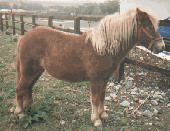Kirdi (also known as Mousseye, Cameroon, Lakka, Logone,
Mbai, and Mussey) ponies come from the Logone River in the sub-Sahel region of
Cameroon (southwest Chad and northern Cameroon). They are named for the
Mousseye tribe in southeastern Cameroon who raise them.
In 1826 they were first noted. It was not until 1926 that a
description of these ponies was actually recorded. Not much research has been
done on them. The population has been rapidly declining and is in danger of
extinction. There have been no regimented breeding programs. However, in 1986
the Cameroon government created an Equine Program to safeguard the Kirdi
(Mousseye Pony) from extinction and to develop the horse industry in Cameroon.
There are some who believe that this breed comes from the blood of the mighty
Barb, having evolved smaller in size because of the shortage of forage. Perhaps
a DNA research program will validate the belief of Barb lineage.
They are docile and willing. They have a large, massive
head, intelligent eyes, small, erect ears, short, thick neck, and short, strong
legs. They possesses great stamina and endurance. They are about 12 hh and are
traditionally chestnut or grey. These ponies are small but also exhibit some
horse-like characteristics.
Interestingly, this fairly rare pony mainly lives in the
area around the river Logone, notorious for the tsetse fly that produced
sleeping sickness. The "Kirdi Pony" appears to be resistant to this,
while other equine breeds are not. They (specifically the Kirdi) lives a very
geographically isolated existence and have been largely unaffected by other
breeds. The Kirdi is used for hunting, riding, transportation, for some
military uses and for barter and money exchange.

